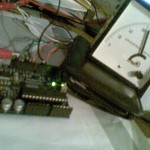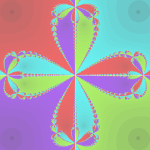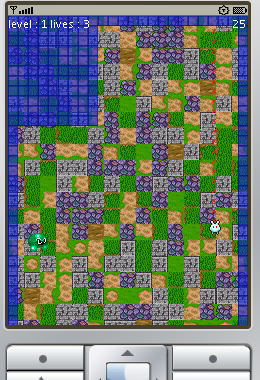November 10, 2007, 7:57 pm
Yesterday I finally got the Arduino, I ordered from Segor Electronics. Which by the way had a good service and packed it securely.
I had a plan to create a Ambient dashboard, that is to have some analog meters that would convey some digital information. In an non obtrusive way, i think it has a very fine name, peripheral awareness.
I found it easy to code the arduino and to work with, so far that is. Using ubuntu I for some peculiar reason had to uninstall braille support, as it automatically recognizes it a braille device.
In order to communicate with the arduino it uses a usb serial connection, that is its connected to the usb port, but it behaves like a serialport. The simple way to send data to the arduino is setting up stty and then you can do stuff from bash like echo “data” >/dev/ttyUSB0 and voila it receives the data.


Here is the prototype setup in all is lousy light condition for mobile cam glory.
There are 5 different meters and they all use PWM, without any capicitors or filters, and it just works, most of the time. Its coded so that when its send a string like 23#34#23#34#34 terminated by a newline, it adjust the displays to the values.(0-254).
Now the next part is to make some kind of script to read relevant information and pass it along to the dashboard, since i use linux some information is available trough acpi as virtual files. But the hunt for easy accessible and relevant data has started, i would really like to display bandwidth usage but so far i haven’t had any luck figuring out where it resides.
Tags:
analog meters,
Arduino,
bandwidth usage,
code,
dashboard,
Electronics,
mobile,
peripheral awareness,
prototype,
pwm,
serialport,
ttyUSB Category:
Arduino,
Electronics,
Programming |
2 Comments
September 22, 2007, 6:47 pm
I the moment I’m taking a course in Numerical Analysis, and here we were of course introduced to the Newton-Raphson method for finding roots. That is the method where, geometrical speaking, we take at tangent line to a function and use that to approximate the root, and keep on doing that until we reach satisfying precision.
Depending on where you start the iteration you get a a different root, and requiring a different amount of iterations. That’s self-evident. The “funny” part is that when searching for complex roots there are areas in the complex plane, where a very small difference in starting point gives different roots, and with remarkable difference in the number of iterations.

This is a plot where each root in the polynomial x^4+2 have been assigned a different color. And each point is colored according to which root a iteration starting here finds.
Now thats the mathematical part of it. Now to the beautiful part or at least more fascinating part. The pattern reapeats it self, as a fractal, when you zoom in.
So i modified my code to zoom in, and i used a diffenrent coloring scheme where i only colored according to the number of iterations taken. This made it possible to generate a video zooming in og showing the rapeating patterns in “nice” colors.
Here a some videos :
4 roots (14.6 mb)
7 roots (50 mb)
Yes I know that its very large files, and maybe i will upload them to google video at a later time for easy viewing and less quality.
Tags:
code,
complex plane,
Fractal,
fun,
newton fractals,
newton raphson method,
numerical analysis,
polynomial,
precision,
roots,
video,
zoom Category:
Art,
Fractal,
Programming |
Comment
July 28, 2007, 5:29 am
Having toyed around with J2ME for the freeVibes, I got a bit hooked on coding for the mobile phone.
So I started to recreate the classic oldskool game Xonix, it’s a game I really like. So simple and addictive. It’s not the first time I’m coding it, I have made it as an applet about a year ago (Xonix applet). As well as being a fun game to play I find it a fun game to code too. Though I have had my share of frustrations. The basic functionality is a fillalgorithm, that has to fill an area on both sides of the line / trail you make with the ‘pilot’. This has to be fast and efficient – nobody likes a game where you have to wait for updates.

Continue reading ‘xonix mobile edition’ »




